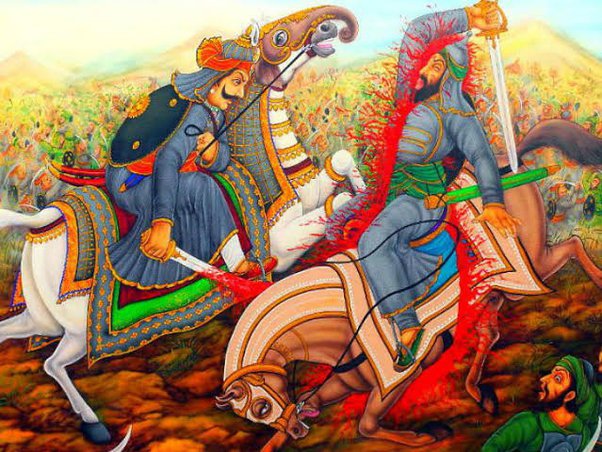How Maharana Pratap defeated the Mughals


Akbar had taken control of North India by 1573. He had already taken Gujarat, and his current goal was to match the accomplishments of earlier Chakravarti rulers. He had chosen his own navratnas in the manner of Vikramaditya. His parents were already being written by his court poets. Mewar was the only region in the northern half of Bharat that was not under his control. The Arab invasions of India had been stopped in the eighth century by Mewar, which was ruled by Bappa Rawal. By its Jauhar-Saka in 1303, Mewar, which had defied the self-proclaimed second Alexander (Sikandar-e-Sani) Alauddin Khilji, had penned a heroic chapter in the history of India. Without conquering Mewar, it would be impossible to go safely to Gujarat.
Maharana Pratap was now in charge of Mewar. For years, Akbar had been sending emissaries to Maharana Pratap. Jalal Khan, Man Singh of Amber, and Todar Mal had all been sent by him.
Pratap graciously declined each request. For him, independence and honor were more important than money. The Mughal monarch, an imperialist, was not amused. He desired to expand both his harem of women and his reign by acquiring more territory. War was inevitable once the battle lines were established.
Since Akbar’s conquest of Chittorgarh in 1568, Mewar had relocated its capital to Gogunda. The “Great” Emperor’s ruthless murder of 30.000 defenseless civilians during the capture was a defining moment. The Maharana waited there for the vast armies of Akbar in order to defend the pass at Haldighati Pass, a strategically important location on the way to Gogunda. The Indian summer was at its height on June 18, 1576.
Man Singh of Amber, Asaf Khan, and Sayyed Ahmed Khan Barha led the Mughal force. Along with Ramdas Rathor, Ramsah Tanwar, Bhamashah, and Hakim Khan Sur, Rana was leading from the front. He was also supported by a small group of patriotic Bheel bowmen led by Chief Punja. According to all sources, the Mughal army was at least three times as large as the Mewar army and had superior equipment. Akbar was arguably the most powerful king on earth at the time. Fighting when defeat appears certain requires a particular type of bravery. Perhaps the courage stemmed from fervent religious convictions or from pride in upholding family honor. Rana remained on the field the entire time.
The battle’s history is too well-known to be discussed here. The bravery of Jhala Sardar, Chetak’s loyalty, Maharana Pratap’s audacity, and Shakti Singh’s homecoming is legendary. The unavoidable took place. The Mughals prevailed thanks to their larger numbers and stronger weapons. One such comment illustrates how statistics affected this particular conflict. The historian Al Badayuni questioned Mughal commander Asaf Khan about how to identify which Rajputs to target with arrows while he was following the Mughal army.
The conflict had been resolved by midday. Rana and a sizable portion of the Mewar Army were fleeing. The fact that the triumphant Mughal Army lacked the guts to pursue them that day is a tribute to their bravery. They were worn out and on guard against forest ambushes.
After a few days, Man Singh conquered Gogunda, Udaipur, and the Kumbhalgarh fort with the whole force of the Mughal Empire at his back. The Mughal army gradually and successfully took control of most of Mewar. Rana was compelled to look for safety in the Mewar jungles. He resided there and awaited the appropriate moment. He abandoned all of the regal comforts. Every year, Akbar launched expeditions with more than a thousand soldiers in his direction. The illustrious generals of Akbar had to settle for Mewar’s dust. Rana waged a guerilla struggle and exacted severe punishment on the Mughals. He gradually reclaimed numerous cities, forts, and towns.
With financial assistance from the affluent Bhamashah, he gathered and prepared a fresh army. He was self-assured enough by 1582 to once more face the Mughals in an open field. With numerous wins under their belts, his battle-tested soldiers were certain they could drive out the Mughals.
Although Dewair is now a peaceful town, it was formerly a key location. It looked out over a ridge that led into Mewar. The Mughals kept their strongest garrison there because they were aware of this. Pratap devised a daring scheme. He would launch a massive assault on Dewair, take it, and compel the Mughals to submit. It was anticipated that the other Mughal garrisons would follow suit. At that time, Mewar was home to 36 Mughal garrisons and posts.
There was a rumor going around that Pratap had fled the Kingdom. The at-ease Mughals were not anticipating any surprises. Dewair was encircled by Maharana Pratap’s army during Vijayadashmi in 1582. Rana was in charge of one wing, and his son Amar Singh was in charge of the other. The Mughal defeat was over. Pratap and Amar engaged the group’s two commanders, Bahlol Khan, and Sultan Khan, in close-quarters fighting. 36000 members of the Mughal army gave themselves up. It was the Mughals’ complete and last defeat in Mewar. The Mughals’ 36 garrisons all submitted. Except for Chittor, which had been lost during his father’s rule, Rana Pratap was able to conquer nearly all of Mewar.
By 1580, Akbar was a very powerful man. By announcing Mahzar, the infallibility proclamation, which elevated him to the position of Supreme Religious Leader in the Kingdom as well as Emperor, he even managed to intimidate the Mullahs. Dewair made him feel uneasy. After it, he made numerous attempts to conquer Mewar. Even he spent six months camped out in an endeavor to overthrow Maharana Pratap. But the Mewar was always victorious over the Mughal troops. They eventually gave up trying. Akbar passed away before realizing his ambition to rule Mewar.
DISCLAIMER: The author is solely responsible for the views expressed in this article. The author carries the responsibility for citing and/or licensing of images utilized within the text.
